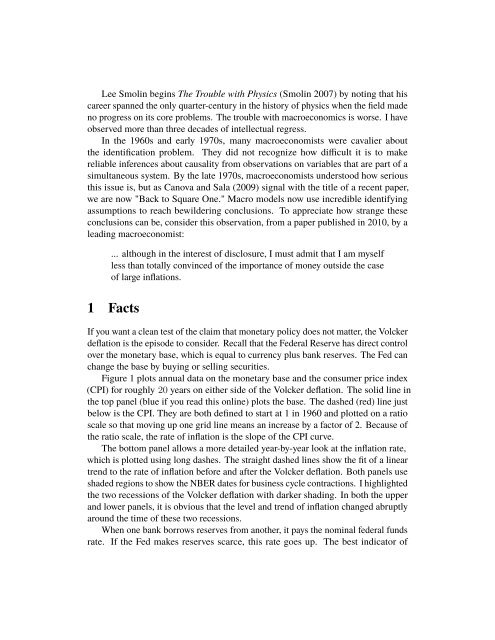The Trouble With Macroeconomics
eziYxDX
eziYxDX
You also want an ePaper? Increase the reach of your titles
YUMPU automatically turns print PDFs into web optimized ePapers that Google loves.
Lee Smolin begins <strong>The</strong> <strong>Trouble</strong> with Physics (Smolin 2007) by noting that his<br />
career spanned the only quarter-century in the history of physics when the field made<br />
no progress on its core problems. <strong>The</strong> trouble with macroeconomics is worse. I have<br />
observed more than three decades of intellectual regress.<br />
In the 1960s and early 1970s, many macroeconomists were cavalier about<br />
the identification problem. <strong>The</strong>y did not recognize how difficult it is to make<br />
reliable inferences about causality from observations on variables that are part of a<br />
simultaneous system. By the late 1970s, macroeconomists understood how serious<br />
this issue is, but as Canova and Sala (2009) signal with the title of a recent paper,<br />
we are now "Back to Square One." Macro models now use incredible identifying<br />
assumptions to reach bewildering conclusions. To appreciate how strange these<br />
conclusions can be, consider this observation, from a paper published in 2010, by a<br />
leading macroeconomist:<br />
... although in the interest of disclosure, I must admit that I am myself<br />
less than totally convinced of the importance of money outside the case<br />
of large inflations.<br />
1 Facts<br />
If you want a clean test of the claim that monetary policy does not matter, the Volcker<br />
deflation is the episode to consider. Recall that the Federal Reserve has direct control<br />
over the monetary base, which is equal to currency plus bank reserves. <strong>The</strong> Fed can<br />
change the base by buying or selling securities.<br />
Figure 1 plots annual data on the monetary base and the consumer price index<br />
(CPI) for roughly 20 years on either side of the Volcker deflation. <strong>The</strong> solid line in<br />
the top panel (blue if you read this online) plots the base. <strong>The</strong> dashed (red) line just<br />
below is the CPI. <strong>The</strong>y are both defined to start at 1 in 1960 and plotted on a ratio<br />
scale so that moving up one grid line means an increase by a factor of 2. Because of<br />
the ratio scale, the rate of inflation is the slope of the CPI curve.<br />
<strong>The</strong> bottom panel allows a more detailed year-by-year look at the inflation rate,<br />
which is plotted using long dashes. <strong>The</strong> straight dashed lines show the fit of a linear<br />
trend to the rate of inflation before and after the Volcker deflation. Both panels use<br />
shaded regions to show the NBER dates for business cycle contractions. I highlighted<br />
the two recessions of the Volcker deflation with darker shading. In both the upper<br />
and lower panels, it is obvious that the level and trend of inflation changed abruptly<br />
around the time of these two recessions.<br />
When one bank borrows reserves from another, it pays the nominal federal funds<br />
rate. If the Fed makes reserves scarce, this rate goes up. <strong>The</strong> best indicator of


